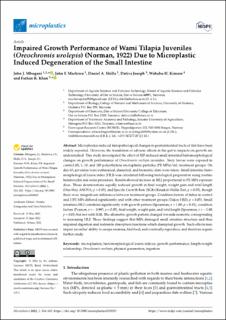| dc.description.abstract | Microplastics-induced histopathological changes in gastrointestinal tracts of fish have been widely reported. However, the translation of adverse effects in the gut to impacts on growth are understudied. This study investigated the effect of MP-induced small intestinal histomorphological changes on growth performance of Oreochromis urolepis juveniles. Sixty larvae were exposed in control (0), 1, 10, and 100 polyethylene microplastic particles (PE MPs)/mL treatment groups. On day 65, juveniles were euthanized, dissected, and biometric data were taken. Small intestine histomorphological lesion index (HLI) was calculated following histological preparation using routine hematoxylin and eosin procedure. Results showed increase in HLI proportional to PE MPs exposure dose. These deteriorations equally reduced growth in final weight, weight gain and total length (One-Way ANOVA, p > 0.05), and Specific Growth Rate (SGR) (Kruskal–Wallis Test, p > 0.05), though there were insignificant differences between treatment groups. Condition factors of fishes in control and 1 PE MPs differed significantly and with other treatment groups (Tukey HSD, p < 0.05). Small intestines HLI correlated significantly with growth pattern (Spearman, r = 1.00, p = 0.01), condition factors (Pearson, r = −0.995, p < 0.05), final weight, weight gain, and total length (Spearman, r = −1.00, p = 0.01) but not with SGR. The allometric growth pattern changed towards isometric corresponding to increasing HLI. These findings suggest that MPs damaged small intestine structure and thus impaired digestion and nutrients absorption functions which disrupted growth. Such effects may impair juveniles’ ability to escape enemies, find food, and eventually reproduce, and therefore require further study. | en_US |

